When I first got my Pleco, my plants started showing signs of nibbling, leaving me puzzled.
Do Plecos eat plants? Are some species more likely to eat plants than others? How can you prevent them from eating plants? And what plants are more vulnerable?
Here, I’ll discuss all these questions, so you leave with all the information you need. Let’s dive right into it.

Do Plecos Eat Plants?
Yes, some Plecos will eat or damage plants, but this behavior often depends on the species of Pleco and the types of plants present in the tank.
Not all Plecos are avid plant-eaters, but several factors can influence their inclination to nibble on foliage.
- Species Variation: While species like the Common Pleco might occasionally nibble on soft plants, others like the Bristlenose Pleco usually leave plants alone and focus on algae.
- Dietary Needs: Plecos with unmet dietary needs might resort to plants for nutrition, especially if they’re not receiving enough greens in their diet.
- Plant Types: Soft, delicate plants like Cabomba or Water Sprite are more likely to be nibbled on by Plecos than tougher varieties like Anubias.
- Tank Environment: Plecos may be more inclined to disturb plants in crowded tanks or in situations where their preferred food sources are scarce.
- Alternative Foods: Offering Plecos a varied diet, including vegetables and algae wafers, can reduce their interest in the plants.
Before we begin, here’s a concise table that outlines which Plecos are likely to consume plants and which are less likely to do so:
| Pleco Species | Eats Plants? |
| Common Pleco | Yes |
| Blue-Eyed Pleco | Yes |
| Rhino Pleco | Yes |
| Amazon Sailfin Pleco | Yes |
| Spotted Pleco | Yes |
| Royal Pleco | Yes |
| Clown Pleco | Yes |
| Rubbernose Pleco | Yes |
| Sailfin Pleco | Yes |
| Gold Spot Pleco | Yes |
| Bristlenose Pleco | No |
| Galaxy Pleco | No |
| Whiptail Pleco | No |
| Redfin Pleco | No |
| Imperial Tiger Pleco | No |
| Sunshine Pleco | No |
| Pictus Pleco | No |
| Green Phantom Pleco | No |
| Peppermint Pleco | No |
| Blue Phantom Pleco | No |
| Snowball Pleco | No |
| Vampire Pleco | No |
| Butterfly Pleco | No |
| King Tiger Pleco | No |
| Zebra Pleco | No |
Also Read: What Do Plecos Eat?
Pleco Species That Are Likely to Eat Plants
Let’s dive into the behavior of several Plecos and their potential to munch on your aquatic plants:
1. Common Pleco (Hypostomus plecostomus)
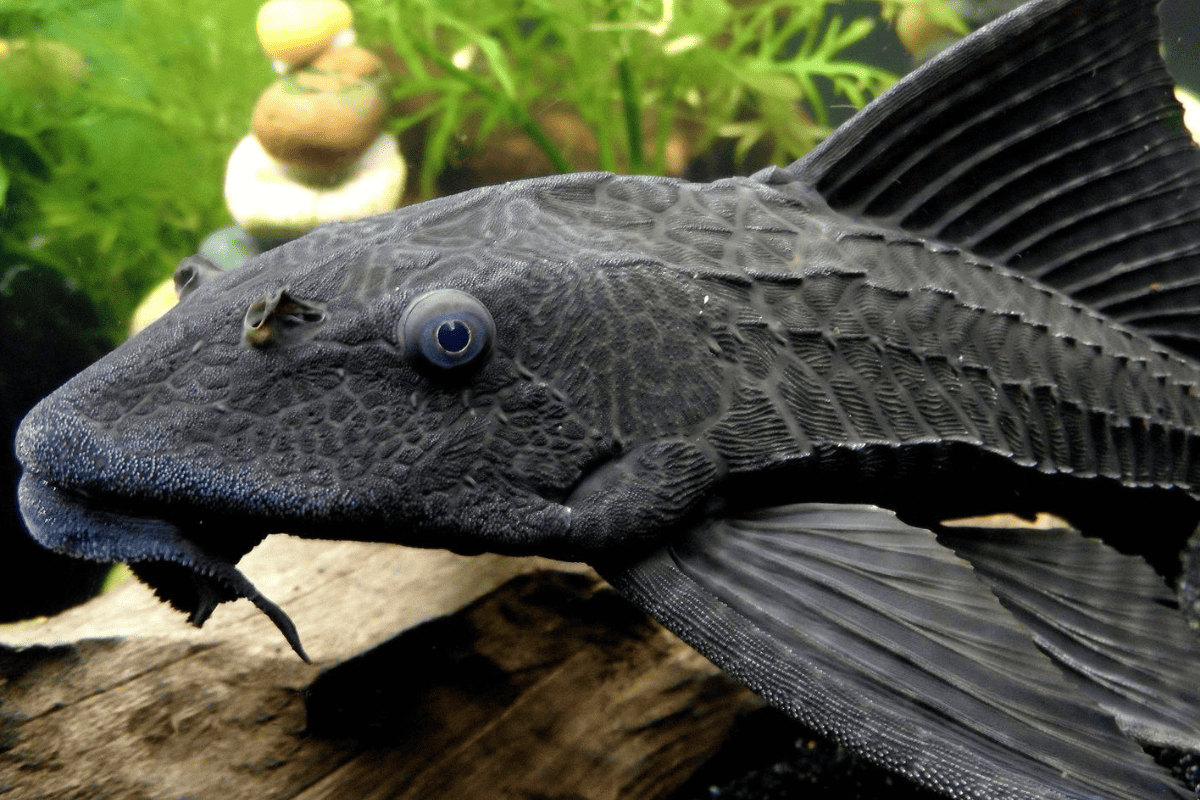
The Common Pleco is often mistaken as a plant-safe choice due to its algae-eating reputation. However, they can cause damage to plants, especially as they grow larger.
- Size Matters: Mature Common Plecos can grow over a foot long, making them heavy and more likely to uproot or damage delicate plants as they move.
- Versatile Diet: While they enjoy algae, they can also graze on plant matter, especially soft, tender plants.
- Tank Setup: Due to their size, Common Plecos need a large tank, increasing the potential for plant disturbance.
2. Gold Spot Pleco (Pterygoplichthys joselimaianus)

This variety is another large species, and like the Common Pleco, they can unintentionally damage plants.
- Physical Disruption: Their size and activity level can cause them to knock over or uproot plants.
- Omnivorous Diet: Gold Spot Plecos might occasionally snack on soft plants.
- Footnote on Size: They can grow to around 20 inches, so be prepared for some unintended plant disturbances.
3. Sailfin Pleco (Pterygoplichthys gibbiceps)

Sailfin Plecos are known for their impressive dorsal fins, but they can be troublesome for planted tanks.
- Big and Active: They grow large, up to 18 inches, and can easily displace or damage plants.
- Beyond Algae: While algae form the majority of their diet, plants aren’t entirely safe.
- Enthusiastic Diggers: Sailfin Plecos might dig around, which can be problematic for plant roots.
4. Rubbernose Pleco (Chaetostoma sp.)
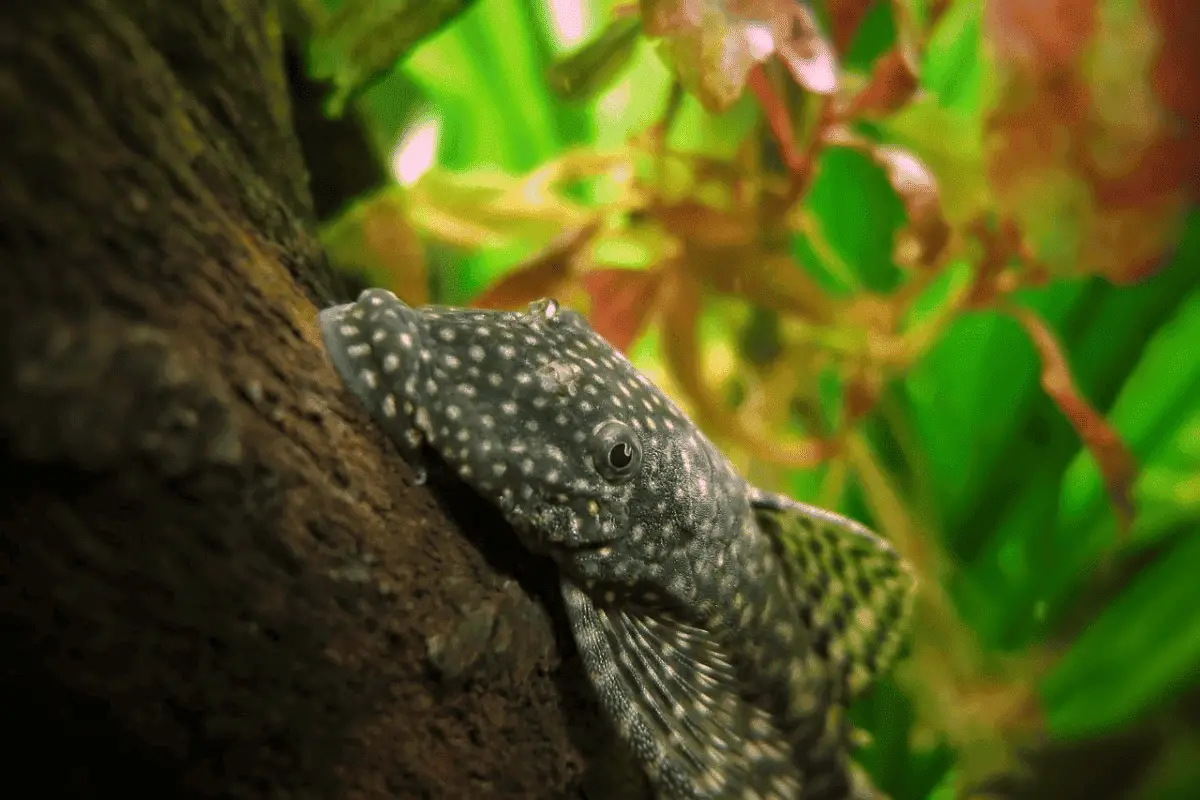
Fortunately, Rubbernose Plecos are generally safer for plants. Still, as with any Pleco, caution is advised.
- Smaller Size: Typically staying below 7 inches, their smaller size is less threatening to plants.
- Rock Grazers: They tend to favor algae on rocks and decorations over plants.
- Watch the Plants: Rare instances might arise where they nibble on plants, but it’s much less frequent than with larger Plecos.
5. Clown Pleco (Panaque maccus)
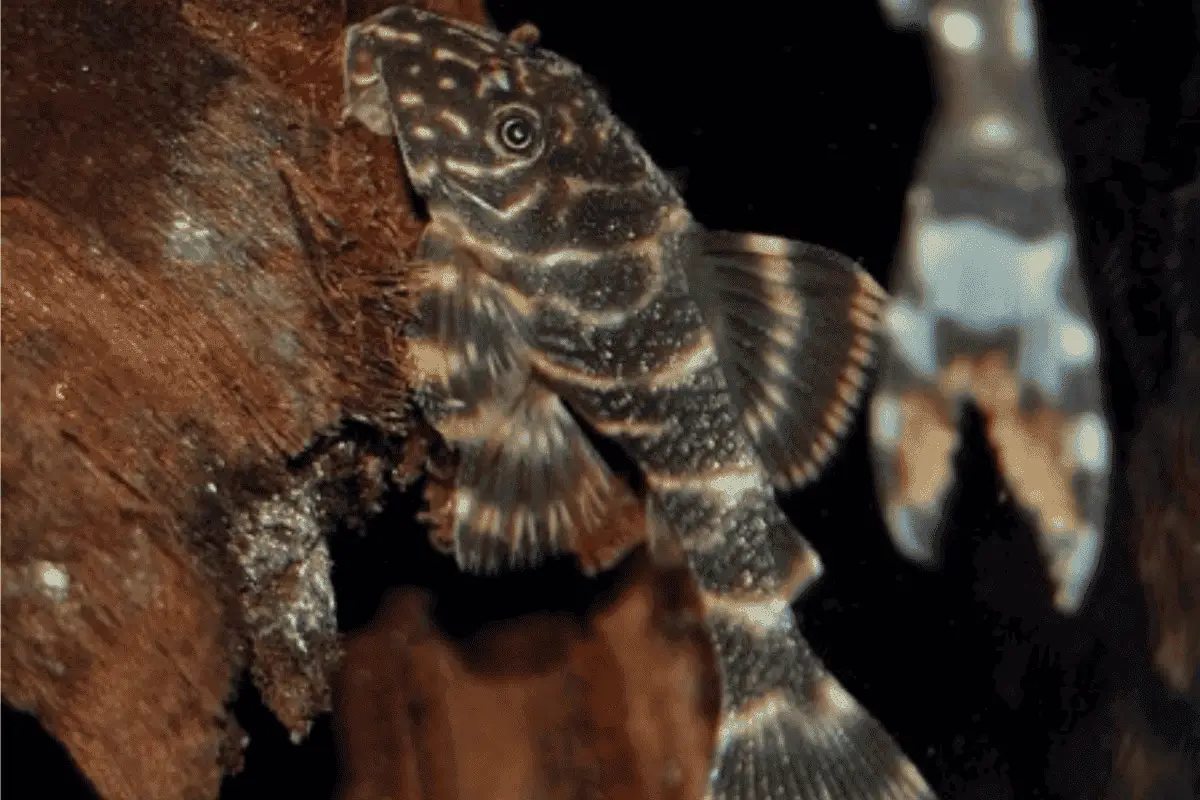
Clown Plecos are quite popular due to their compact size and unique patterns.
- Size Advantage: Rarely growing beyond 4 inches, they’re far less likely to inadvertently damage plants.
- Wood Lovers: Their primary diet consists of wood, making them less of a threat to plants.
- Occasional Grazers: While they prefer wood, they might sometimes graze on plant matter, but it’s not a regular occurrence.
6. Royal Pleco (Panaque nigrolineatus)

The Royal Pleco is an impressive fish with its regal appearance and distinct behavior.
- Sizeable Species: Growing up to 17 inches, the Royal Pleco can become a dominant figure in the tank, potentially causing plant disturbances.
- Woody Diet: Renowned for their love of wood, they chew on it for cellulose but can sometimes forage around plants.
- Plant Safety: While wood is their main preference, it’s always a good idea to monitor them around delicate plants, especially if the Pleco is hungry or curious.
7. Spotted Pleco (Pterygoplichthys pardalis)

With striking spots, the Spotted Pleco is a sight to behold, but they come with considerations for plant lovers.
- Growing Concerns: They can achieve sizes up to 20 inches, which, similar to their other large Pleco cousins, can spell potential problems for plants.
- General Diet: Like many Plecos, they enjoy a varied diet that can sometimes include plants, especially if the tank doesn’t provide enough algae or other food sources.
- Activity Alert: Spotted Plecos are quite active, especially during the night, so you might find plants uprooted or damaged due to their nocturnal escapades.
Pleco Species That Wouldn’t Eat Plants
On the other hand, here are a few Pleco species that are less likely to eat plants:
1. Bristlenose Pleco (Ancistrus sp.)
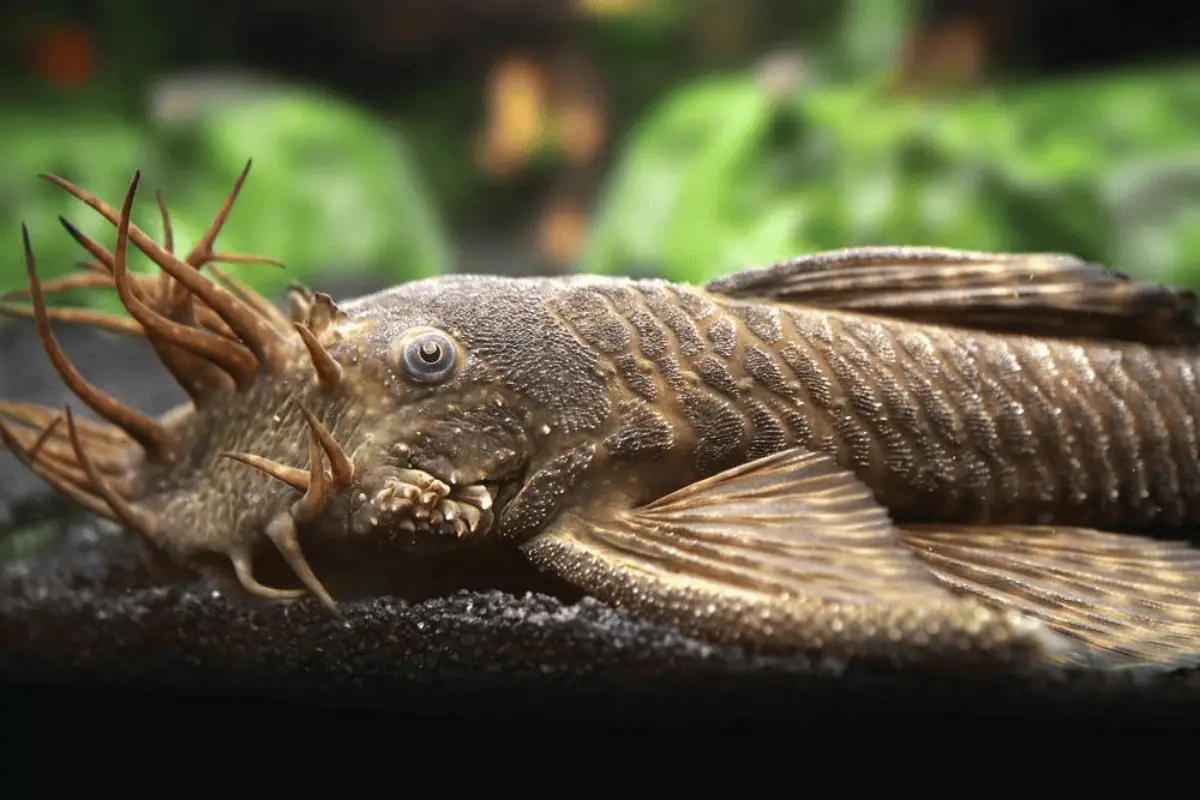
The Bristlenose Pleco is a favorite among many aquarists because of its manageable size and plant-friendly nature. They’re one of the best Plecos for a planted tank.
- Size is Key: Generally, Bristlenose Plecos reach a length of only 4-6 inches, making them less likely to unintentionally damage plants.
- Diet Preferences: They have a strong appetite for algae and often choose this over plant matter.
- Tank Compatibility: Their peaceful temperament and dietary habits make them a top choice for planted aquariums.
2. Zebra Pleco (Hypancistrus zebra)
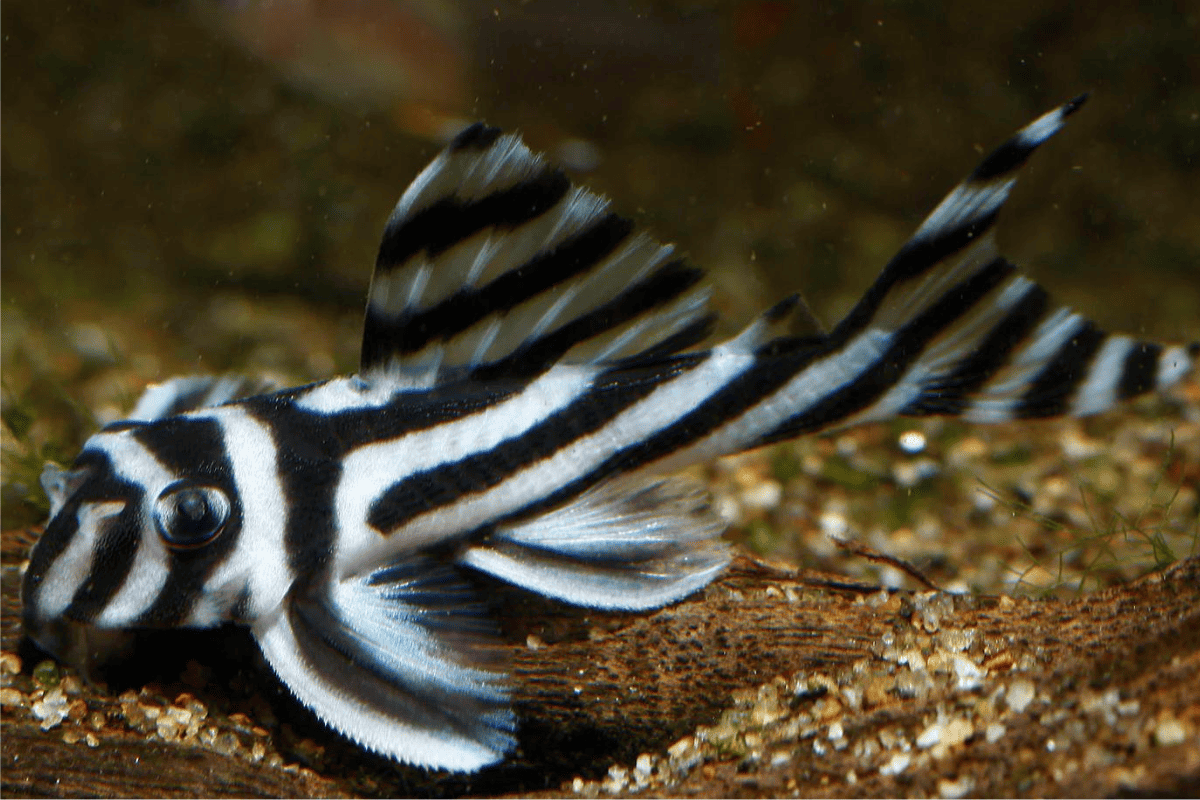
With their stunning black and white stripes, Zebra Plecos are quite the showstopper, and fortunately, they’re gentle on plants.
- Carnivorous Tendencies: Zebra Plecos prefer meaty foods, which means plants are generally safe from their nibbles.
- Smaller in Size: Growing up to 3-4 inches, their compact size reduces the chance of plants being uprooted.
- Hiding Habit: These Plecos are more reclusive, spending lots of time in hides, causing less disruption in the tank.
3. King Tiger Pleco (Hypancistrus sp. L066)

This boldly patterned Pleco is another plant-friendly option for aquarists.
- Meat Lovers: Their diet mainly consists of meaty foods, ensuring minimal risk to your plants.
- Stay Small: King Tiger Plecos usually max out at about 5 inches, reducing plant disturbance.
- Shy Nature: They prefer hiding and won’t actively seek out plants to munch on, ensuring your greenery remains untouched.
4. Butterfly Pleco (Dekeyseria sp.)

Known for its unique appearance, the Butterfly Pleco is another suitable choice for planted tanks.
- Feeding Habits: These Plecos love grazing on algae-covered surfaces without targeting actual plant matter.
- Petite Stature: With a size hovering around 6 inches, they’re less likely to inadvertently harm plants.
- Peaceful Demeanor: Their calm nature ensures they coexist harmoniously with plants and other tank inhabitants.
5. Vampire Pleco (Leporacanthicus galaxies)

Sporting spectacular colors and textures, the Vampire Pleco is both a visual treat and a plant ally.
- Specialized Diet: Vampire Plecos have a penchant for meaty foods, making plants largely safe from their grasp.
- Subdued Size: Generally reaching up to 10 inches, their size is manageable, meaning less disturbance to flora.
- Tank Behavior: While they’re active, these Plecos aren’t known to nibble on plants, but they do need plenty of hides and space to explore.
6. Snowball Pleco (Hypancistrus inspector)

Named for its distinct spotted appearance, the Snowball Pleco is another good neighbor for aquatic plants.
- Carnivorous Appetite: Their preference leans towards meat-based foods, posing little threat to plants.
- Growth Range: Snowball Plecos usually reach sizes of 5-6 inches, making them less likely to accidentally harm plants.
- Peaceful Nature: They’re non-aggressive and usually don’t bother plants, making them ideal for planted aquariums.
7. Blue Phantom Pleco (Hemiancistrus sp. L128)

This vibrantly colored Pleco is a lovely sight in tanks and generally doesn’t harm plants.
- Diet Preferences: Blue Phantom Plecos enjoy both algae and meaty foods but usually avoid eating plants.
- Moderate Size: They can grow up to 7 inches, yet they typically don’t disturb plant life significantly.
- Easy-going Temperament: They have a calm disposition, allowing them to fit well in planted tanks without stressing the plants.
Plant Types That Can Be Easily Eaten By Plecos
Just as some Plecos are more inclined to eat plants, some plants are more susceptible to Plecos’ nibbling:
1. Amazon Sword (Echinodorus amazonicus)

The Amazon Sword, with its broad leaves, can be an inviting surface for Plecos to graze upon.
- Broad Leaves: Plecos often see these large surfaces as perfect spots for grazing, which can lead to leaf damage.
- Soft Texture: The Amazon Sword’s relatively soft leaves can easily show wear and tear from Pleco activity.
- Plant Vulnerability: Younger plants with tender leaves are especially susceptible to Pleco munching.
2. Cabomba (Cabomba caroliniana)
Cabomba’s delicate, feathery leaves are beautiful but might not stand up to a determined Pleco.
- Feathery Foliage: Plecos can easily pull apart the thin, delicate tendrils of the Cabomba when they’re foraging.
- Not Sturdy: Compared to tougher plants, Cabomba doesn’t offer much resistance to Plecos’ grazing habits.
- Rapid Damage: Due to its delicate nature, even a short grazing session by a Pleco can make the plant look tattered.
3. Water Sprite (Ceratopteris thalictroides)

This plant, while resilient in many settings, can be vulnerable to Plecos’ attention.
- Fine Leaves: Water Sprite’s lace-like leaves can be easily torn by Plecos, especially when they’re searching for food.
- Floating Snack: If left floating, it offers a readily accessible snack for any Pleco looking to graze.
- Quick Recovery: On the bright side, Water Sprites grow quickly, but Plecos might hinder their full potential.
4. Java Fern (Microsorum pteropus)
Java Ferns are a popular choice in many tanks, but they’re not always safe from Plecos.
- Tougher Choice: While tougher than some plants on this list, determined Plecos might still snack on them.
- Root Attachments: If not firmly attached, Plecos might unintentionally uproot or disturb them during their adventures.
- Visible Damage: Scratches and grazes on the Java Fern’s leaves can be quite visible and unsightly after a Pleco’s attention.
5. Elodea (Elodea canadensis)

Often used in classrooms and aquariums, Elodea isn’t immune to Pleco activities.
- Easily Broken: Elodea’s segments can be easily broken off by Plecos during their explorations or grazing.
- Soft Nature: Its softer texture makes it a potential food source for Plecos, especially if other food is scarce.
- Growth Rate: While Elodea grows quickly, frequent disturbances by Plecos can stymie its growth.
Plant Types That Are Not Likely to Get Eaten By Plecos
On the other hand, here are a few plants that are more resilient to Plecos:
1. Anubias (Anubias sp.)

Anubias, with its tough, leathery leaves, often goes untouched in a tank shared with Plecos.
- Thick Leaves: Their robust leaf structure isn’t as appealing to Plecos, making it less likely they’ll graze on them.
- Slow Grower: Even though Anubias grows slowly, Plecos generally won’t hinder its growth rate by munching on it.
- Low Position: Typically placed on rocks or driftwood, its positioning makes it less of a direct grazing ground for Plecos.
2. Java Moss (Taxiphyllum barbieri)
This hardy, small-leaved plant is versatile and often avoids Pleco nibbling.
- Dense Growth: Plecos usually aren’t attracted to its dense and intricate growth, looking for larger surfaces to graze on.
- Cover & Safety: Java Moss offers shelter and cover for other creatures, without being the main meal for Plecos.
- Adaptive Nature: Growing on various surfaces, its adaptable nature keeps it thriving even in the presence of Plecos.
3. Cryptocoryne (Cryptocoryne sp.)

The Crypts, being quite diverse, have managed to coexist with Plecos due to a few reasons.
- Variable Texture: Many Crypt species have thicker leaves, which deter Plecos from snacking.
- Less Attractive: While they can be quite beautiful, their appeal to Plecos as food seems to be minimal.
- Established Roots: With a strong root system, Crypts can resist the occasional Pleco digging or passing by.
4. Vallisneria (Vallisneria sp.)
Known for its tall, grass-like appearance, Vallisneria stands tall against Pleco interests.
- Tough Structure: Its linear and firm structure isn’t the first choice for Plecos searching for a snack.
- Fast Growth: Vallisneria’s rapid growth ensures that even if a Pleco showed interest, the plant could recover quickly.
- Deep Roots: Their rooted nature in the substrate makes them less likely to get disturbed by the wandering Pleco.
5. Rotala (Rotala sp.)

Rotala’s vibrant stems and fine leaves often fly under the Pleco radar.
- Stem Plant: Being a stem plant, Rotala is less likely to attract Plecos looking for broad leaves to graze on.
- Quick Recovery: Even if a Pleco decided to explore, Rotala’s growth rate helps it bounce back.
- Visual Appeal: While aquarists adore its colors, Plecos generally leave this plant alone, preferring other food sources.
How to Prevent Your Pleco from Eating Plants
Keeping your Pleco from feasting on your plants requires some thoughtful strategies. Here’s what you should do:
- Varied Diet: Introduce a mix of sinking pellets and algae wafers; for instance, feed them a high-quality wafer every two days.
- Vegetable Supplements: Plecos love blanched veggies; try offering slices of zucchini, cucumber, or spinach twice a week.
- Adequate Feeding: Monitor your Pleco’s intake; if they consume their food within 10-15 minutes, consider it a good feeding amount.
- Regular Monitoring: Keep an eye on your plants; if you notice bite marks, it’s a sign to adjust the Pleco’s diet.
- Stable Environment: Plecos stress less in stable conditions. Keep temperature around 76-80°F and pH between 6.5-7.5.
- Tank Enrichment: Add driftwood; some Pleco species, like the Clown Pleco, derive nutrients from gnawing on it.
- Hideouts: Create hideouts using rocks or caves. A comfortable Pleco is less likely to disturb plants.
- Plant Choice: Opt for tougher plants like Anubias; their leathery leaves are less appealing to Plecos.
- Barrier Method: Use mesh or grids to separate young plants from Plecos, giving plants time to establish.
- Night-time Feeding: Plecos are more active at night. Drop some food in after lights out to ensure they’re satisfied.
- Frequent Checks: Regularly inspect your Pleco’s mouth and belly. A well-fed Pleco has a rounded belly and won’t seek plants for sustenance.
Alternatives for Live Plants
For aquarists aiming to keep their Plecos comfortable without the challenge of live plants, there are multiple alternatives to create a safe and natural environment.
These alternatives can provide the same sense of security and enrichment that live plants offer.
- Driftwood: Essential for many Plecos, driftwood offers them a surface to graze on, and some species even extract nutrients from it. My recommendation: Dr. Moss Malaysian Driftwood (link to Amazon).
- Caves and Hideouts: Using terracotta pots or specialized fish caves can provide Plecos with a secure spot to retreat and rest.
- Artificial Plants: While they don’t offer nutritional benefits, silk or soft plastic plants can mimic the feel and shelter of real ones, making Plecos feel at home.
- Leaf Litter: Adding dried almond leaves or similar can offer a natural foraging ground for Plecos and even release beneficial tannins. I personally like the Premium Indian Almond Leave (link to Amazon).
- Floating Ornaments: Floating logs or hollow decorations at the surface can create a shadowy environment, helping Plecos feel safe and sheltered.
Also Read: Do Plecos Eat Snails?
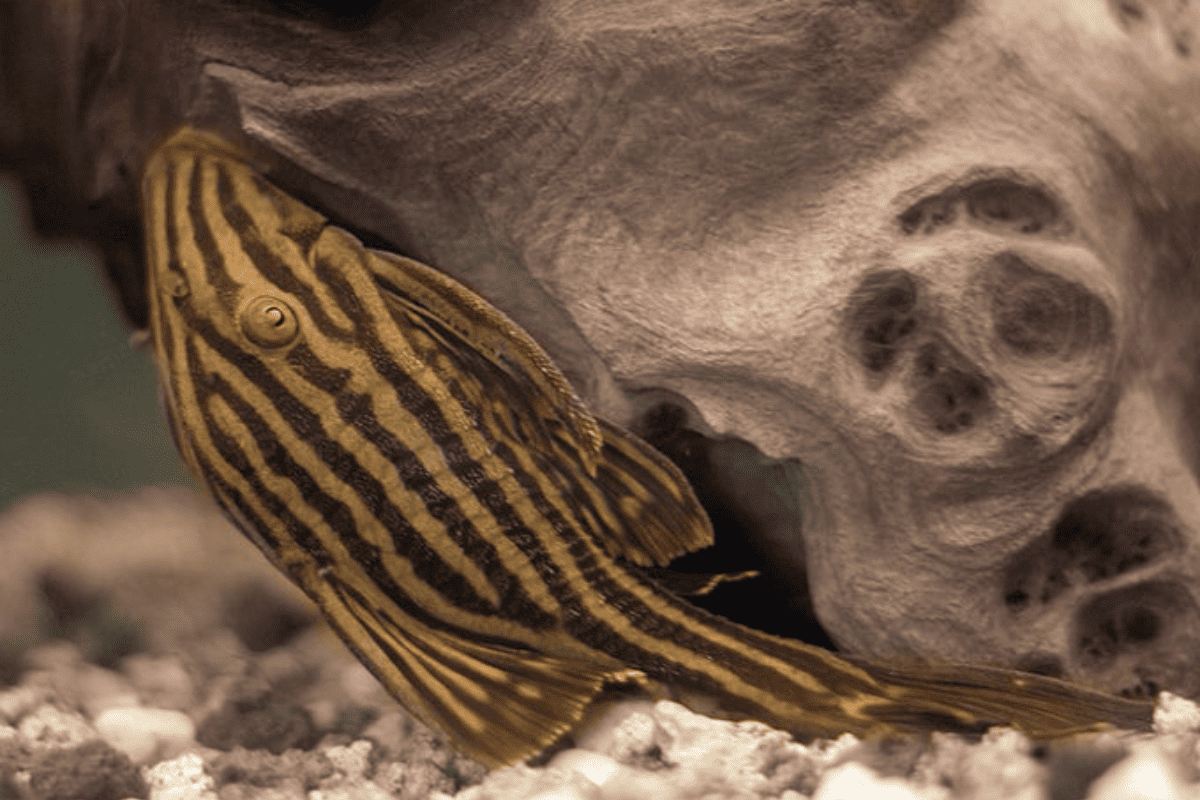
Do Plecos Eat Dead Plants?
Yes, Plecos often eat dead or decaying plant matter.
While they primarily graze on algae, detritus, and other particles, they won’t shy away from decaying plant material if it’s available.
- Natural Scavengers: Plecos, especially in the wild, are opportunistic feeders. Dead plants provide an easy food source they’re inclined to utilize.
- Tank Cleanup: In a home aquarium, Plecos might munch on dead plants as a part of their role in keeping the tank free from excess debris and waste.
- Nutritional Intake: While dead plants might not be their primary choice, Plecos can still derive certain nutrients from them, especially when other food sources are scarce.
Do Plecos Eat Algae off Plants?
Yes, Plecos are well-known for their algae-eating capabilities and will often eat algae off plants. In many cases, they are introduced to tanks specifically for this algae-cleaning role.
- Efficient Grazers: Plecos use their specialized mouths to scrape off algae from various surfaces, including plant leaves.
- Selective Eating: However, some Plecos can be a little too aggressive and might nibble on the plant itself if the algae is insufficient.
- Algae Control: Keeping a Pleco for this purpose can help maintain the balance of algae in a planted tank, but be sure to monitor the health of your plants.
Also Read: Do Plecos Eat Algae?
Can I Feed My Plecos Vegetables?
Yes, you can absolutely feed your Plecos vegetables. Vegetables are a great way to supplement their diet and keep them well-fed, reducing their inclination to nibble on plants.
- Types of Veggies: Popular options are cucumber slices, zucchini pieces, and blanched spinach. You can offer these to them a few times a week.
- Preparation: It’s best to blanch the veggies first to make them softer and more palatable for the Plecos.
- Serving Method: Consider using a veggie clip to secure the veggie slices at the tank’s bottom, making it easy for Plecos to reach them.

Conclusions
For the quick readers, here’s a brief summary:
- Different Pleco species have varying propensities to consume plants. For instance, the Common Pleco and Gold Spot Pleco are more inclined to harm plants due to their size and eating habits.
- On the other hand, smaller Plecos like the Bristlenose and Clown Pleco are generally more plant-friendly, posing less threat to them.
- The kind of plants you have in your aquarium is crucial. Softer plants like Cabomba and Water Sprite are more prone to Pleco nibbles.
- To discourage Plecos from feasting on plants, ensure a diverse diet for them, comprising sinking pellets, algae wafers, and blanched veggies.
- You can introduce non-living elements like driftwood, caves, and faux plants to establish a secure and natural habitat for Plecos without jeopardizing your live plants.

